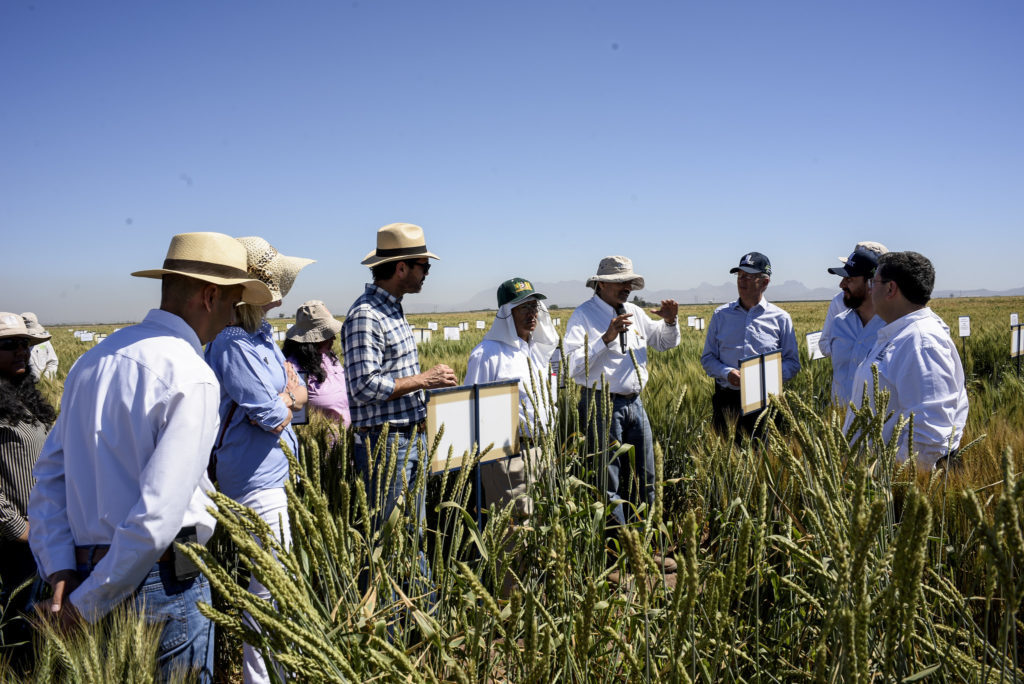By Mathew Reynolds, Wheat Physiologist at, CIMMYT
First post of our “Global Collaboration” series
Wheat is the most widely grown crop in the world, currently providing about 20 percent of human calorie consumption. However, demand is predicted to increase by 60 percent within just 30 years, while long-term climate trends threaten to reduce wheat productivity, especially in less developed countries.
CIMMYT, HeDWIC and IWYP
For over half a century, the International Wheat Improvement Network (IWIN), coordinated by CIMMYT, has been a global leader in breeding and disseminating improved wheat varieties to combat this problem, with a major focus on the constraints of resource poor farmers.

Two complementary networks — the Heat and Drought Wheat Improvement Consortium (HeDWIC) and the International Wheat Yield Partnership (IWYP) — are helping to meet the future demand for wheat consumption through global collaboration and technological partnership.
By harnessing the latest technologies in crop physiology, genetics and breeding, network researchers support the development of new varieties that aim to be more climate resilient, in the case of HeDWIC and with higher yield potential, in the case of IWYP.
Novel approaches
These novel approaches to collaboration take wheat research from the theoretical to the practical and incorporate science into real-life breeding scenarios. Methods such as screening genetic resources for physiological traits related to radiation use efficiency and identifying common genetic bases for heat and drought adaptation are leading to more precise breeding strategies and more data for models of genotype-by-environment interaction that help build new plant types and experimental environments for future climates.
IWYP addresses the challenge of raising the genetic wheat yield potential of wheat by up to 50 percent in the next two decades. Achieving this goal requires a strategic and collaborative approach to enable the best scientific teams from across the globe to work together in an integrated program. TheIWYP model of collaboration fosters linkages between ongoing research platforms to develop a cohesive portfolio of activities that maximizes the probability of impact in farmers’ fields IWYP research uses genomic selection to complement the crossing of complex traits by identifying favorable allele combinations among progeny. The resulting products are delivered to national wheat programs worldwide through the IWIN international nursery system.
Recently, IWYP research achieved genetic gains through the strategic crossing of biomass and harvest index — source and sink — an approach that also validates the feasibility of incorporating exotic germplasm into mainstream breeding efforts.
In the case of HeDWIC, intensified — and possibly new — breeding strategies are needed to improve the yield potential of wheat in hotter and drier environments. This also requires a combined effort, using genetic diversity with physiological and molecular breeding and bioinformatic technologies, along with the adoption of improved agronomic practices by farmers. The approach already has proof of concept in the release and adoption of three heat and drought tolerant lines in Pakistan.
Next
It is imperative to build increased yield and climate-resilience to into future germplasm in order to avoid the risk of climate-related crop failure and to maintain global food security in a warmer climate. Partnerships like HeDWIC and IWYP give hope to meeting this urgent food security challenge.
Further readings:
https://www.hedwic.org/resources.htm
https://royalsocietypublishing.org/doi/full/10.1098/rspb.2012.2190
An economist’s perspective on plant sciences: Under-appreciated, over-regulated and under-funded








